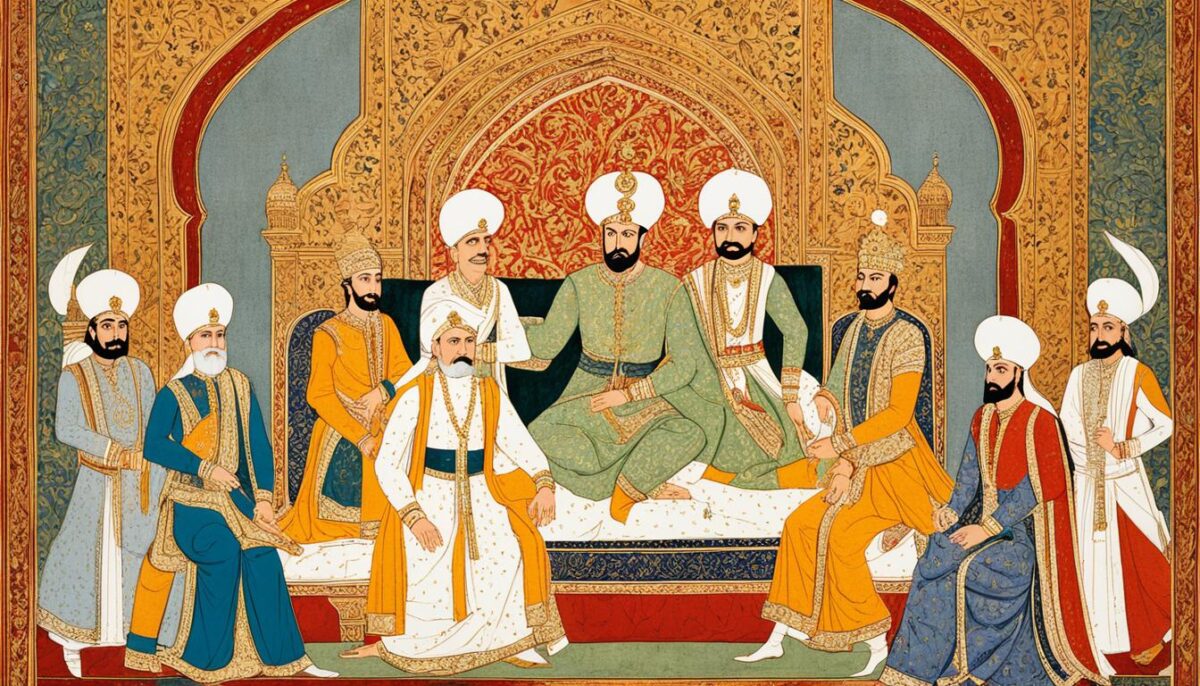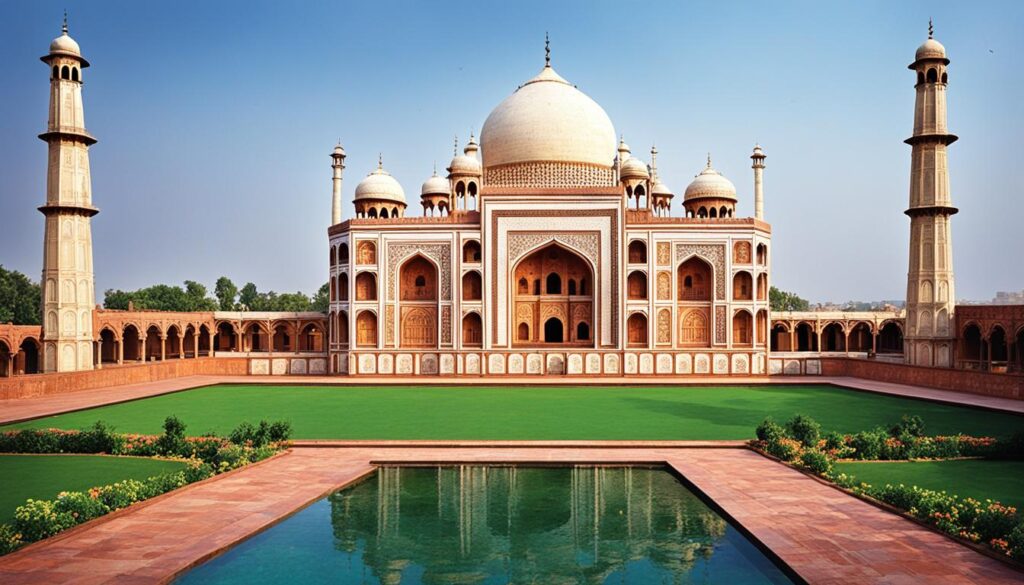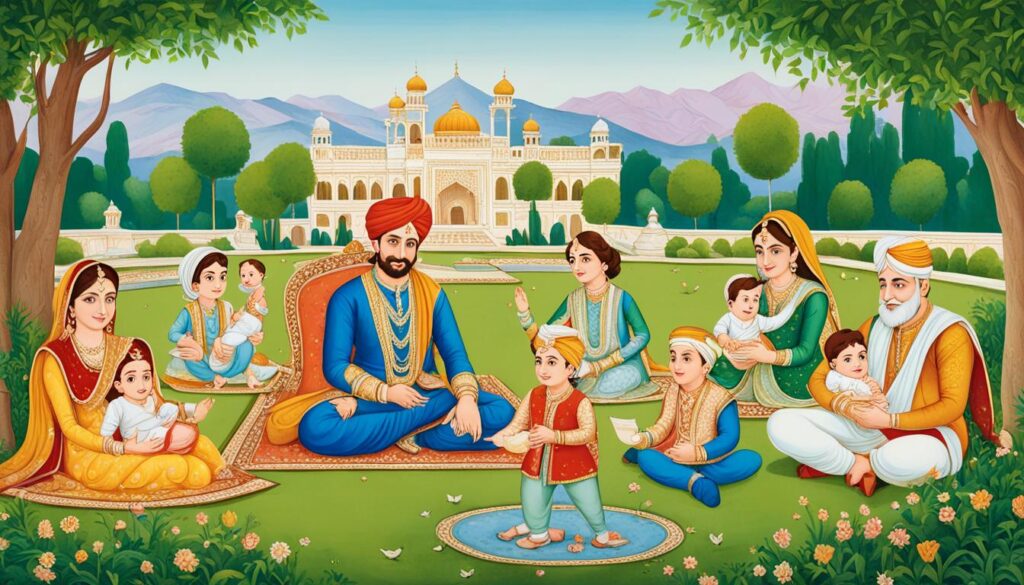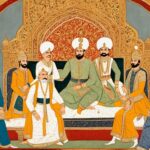Imagine a time when an emperor’s vision and leadership transformed a nation. This king’s story is about Akbar, the third Mughal emperor. He ruled over India from 1556 to 1605. Akbar, whose full name was Abū al-Fatḥ Jalāl al-Dīn Muḥammad Akbar, is a key figure in Indian history. He’s known for military success, changes in how the country was run, being open to all religions, and supporting the arts. These qualities made him one of the best emperors in Indian history.1
But why is Akbar so respected, and how did he change Mughal history? Let’s explore the life and impact of Shahenshah Akbar. He earned the title “King of Kings.” We’ll discover what made him a giant of his era.
Key Takeaways
- Akbar reigned as the 3rd Mughal Emperor from 1556 to 1605,1 consolidating Mughal control over most of the Indian subcontinent.2
- Akbar was known for his military campaigns, administrative reforms, religious tolerance, and patronage of arts and culture.2
- Akbar’s policies of conciliation and conquest towards the Hindu Rajputs led to marriage alliances and greater Hindu participation in his government.2
- Akbar’s court was a center of cultures, where scholars, poets, and artists were encouraged to showcase their work, contributing to the cultural enlightenment during his reign.3
- Akbar’s religious policies, such as the abolition of discriminatory taxes and the promotion of religious diversity, fostered harmony and support from his non-Muslim subjects.3
Introduction to Akbar the Great
Early Life and Ancestry
Akbar came from a mix of Turks, Mongols, and Iranians. His family tree includes Timur (Tamerlane) and Genghis Khan.3 He spent his early years in Kabul with his uncles and aunts. They taught him outdoor skills but not how to read or write.1 At 9, he was made governor of Ghazni and married his first wife, Ruqaiya Sultan Begum, who was also his cousin.
Rise to Power at a Young Age
In 1555, Akbar’s father Humayun took back Delhi with help from the Persian ruler Tahmasp I.1 Soon after, Humayun passed away. Akbar, just 13, became the new king.1 His guardian Bairam Khan kept Humayun’s death a secret. This was to make sure Akbar could become king smoothly.1 In Kalanaur, Punjab, Bairam Khan led Akbar’s coronation. There, Akbar was declared Shahanshah at the age of 14.
Military Campaigns and Expansion
Akbar’s military campaigns strengthened the Mughal rule in the Indian subcontinent. He brought changes to the mansabdari system, making a clear order of military and civil ranks.1 Akbar also improved cannons, fortified defenses, and the use of elephants. He led the use of matchlocks in battle.1 After winning at the Second Battle of Panipat in 1556, Akbar and his regent Bairam Khan defeated Sikandar Shah Suri in Punjab. This victory allowed the Mughals to claim Lahore and Multan.1
Conquest of Northern India
In 1559, the Mughals moved south into Rajputana and Malwa.1 In 1568, Akbar took the fortress at Chitor in Mewar, but showed no mercy to those who didn’t recognize him as the ruler.1 This resulted in other Rajput rulers seeing Akbar as the emperor and forming marriage ties with him.1 In 1573, Akbar conquered Gujarat, a key region for trade with western Asia.2
Annexation of Central and Western India
In the later years of his rule, Akbar started more conquests. He took Kashmir in 1586,2 Sindh in 1591,2 and Kandahar (now in Afghanistan) in 1595.2 Moving south of the Vindhya Range into the Deccan, the Mughals added Khandesh, Berar, and part of Ahmadnagar by 1601.2 By this time, Akbar had control over two-thirds of the Indian subcontinent.2
Shahenshah Akbar: Expansion into South India
During his reign, Akbar extended Mughal dominance over most of the Indian subcontinent.2 He showed strategic brilliance and used new tactics and technology to grow the Mughal Empire. To solidify control, Akbar wisely integrated the lands he conquered and formed alliances through marriage diplomacy.
Administrative and Economic Reforms
Akbar, to unite the Mughal state, set up a centralized government.2 He used friendly ways to deal with those he conquered, like marrying into their families and diplomacy.2 This helped build peace. He let Hindus, especially the brave Rajputs, join the Mughal service. Many reached high posts, like generals and governors.2 This made sure that people of all faiths had opportunities, cutting back on bias.2
Centralization of Power and Reorganization
Akbar focused on streamlining how money was managed and taxes were collected.2 He stopped taxing pilgrims and the tax non-Muslims paid instead of serving in the military. This move showed his respect for different beliefs and aimed to be fair to all.2
Financial Reforms and Tax Collection
Under Akbar’s rule, the Mughal Empire saw its economy and wealth grow threefold. This allowed businesses to flourish and supported the blending of Indian and Persian cultures.1 His policies brought non-Muslims on board. For example, he got rid of the special tax they had to pay.1
Akbar’s Religious Tolerance and Inclusivity
Akbar, the third Mughal emperor, is famous for his open-mindedness towards religion. While he was a follower of Islam, he showed great interest in other faiths. He invited Hindus, Parsis, Christians, and Muslims to share their beliefs at gatherings.2 He implemented policies that made non-Muslims feel more welcome, reducing bias against them.2
Abolition of Discriminatory Taxes
He got rid of taxes that targeted non-Muslims, taxes like those for pilgrimages or as substitutes for joining the military.1 By doing this, he worked towards making his empire more united.1
Promotion of Religious Diversity
Akbar made sure everyone could freely practice their faith.2 He also welcomed scholars, poets, and artists from different faiths to his court. This made his empire a vibrant center for learning and the arts.2
Din-i-Ilahi: Akbar’s Syncretic Faith
At a point, Akbar was not satisfied with the typical teachings of Islam. So he introduced Din-i Ilahi, a mix of parts from Islam, Hinduism, Zoroastrianism, and Christianity. The goal was to unite his people under a common spiritual path.2 This effort to blend religions marked Akbar’s rule and enhanced Mughal culture and thinking.
Rajput Alliance and Marriage Diplomacy
Akbar took a wise approach when dealing with the Rajput rulers. This group was an independent Hindu warrior class, living in the harsh lands of Rajputana.1 He let them keep their lands but under his rule. They honored him, paid tribute, and agreed to marry into his family.1 Thanks to this strategy, Akbar got the Rajputs to support his government.
Patronage of Arts, Literature, and Culture
Akbar’s courts were a big deal at places like Delhi, Agra, and Fatehpur Sikri. Lots of people came there: from holy men to poets, and from architects to artisans. It became a hub for the arts, literature, and learning.1 Under Akbar, a mix of Timurid and Perso-Islamic cultures joined with Indian ways. This led to a special style in Mughal buildings and paintings.
Mughal Architecture and Fatehpur Sikri
Akbar left a grand mark in the form of Fatehpur Sikri. This city was his capital and a symbol of being an emperor, called shahenshah. It shows a mix of Timurid, Persian, and Indian styles. Therefore, it’s a key part of the Mughal era’s cultural tale.
Promotion of Painting, Poetry, and Music
Akbar couldn’t read or write but loved the arts.1 He supported learning, the arts, and music at his court. He was big on Mughal paintings, poetry, and music, and helped take them to new levels of beauty and talent.1 His ruling time saw a big pull of talented people like artisans, philosophers, and poets from all over. This made his places stand out for creativity and intelligence.1
Legacy and Impact of Akbar’s Reign
Akbar’s rule shaped the powerful Mughal Empire through military might, smarter administration, and a unique blend of religions and cultures. This approach was carried on after him, especially by his son Jahangir.2 We see Akbar’s time as the Mughal Empire’s golden era – a time of great success and cultural growth.1
Establishment of Mughal Dynasty
Akbar made the Empire feel like one, linking everyone despite their differences. He used a mix of religious freedom, smart marriages, and getting different groups involved in running things.3 This made the Empire enjoy a big cultural and intellectual boom.
Cultural Integration and Unity
His battles expanded the Mughal territory hugely, making it cover most of India.3 Akbar managed and ruled this vast land by accepting all beliefs and including everyone in governance. This made life better and more united for all.
Personal Life and Family
Wives and Children
Akbar married six times3. His first wife was Ruqaiya Sultan Begum, who was his cousin too.1 Others were like Salima Sultan Begum, daughter of a Mirza, and Jodha Bai, whose real name was Mariam-uz-Zamani. She was a daughter of a Rajput leader from Ajmer.1 He had five sons3, with Daniyal Mirza being his favorite, sharing Akbar’s love for poetry. Prince Salim, later Jahangir, became his successor.1
Succession and Later Years
Later, Akbar faced trouble from his son Salim, who wanted control.2 Even so, Salim became the next Mughal emperor as Jahangir after Akbar’s passing. Akbar died of dysentery in 1605 at 63.13
Death and Burial of Akbar the Great
Akbar, the third Mughal Emperor, ruled from 1556 to 1605. He became emperor on 14 February 1556.1 He passed away on October 27, 1605, at age 63. Akbar died in Fatehpur Sikri, close to Agra, from dysentery. Dysentery is a severe infection in the intestines, causing bloody diarrhea.1 Akbar’s birth was on October 15, 1542, in Amarkot, Rajputana, which is now Umerkot, Sindh, Pakistan. He was laid to rest in November 1605 at Akbar’s Tomb in Sikandra, Agra, India.1
This grand structure reaches 100 feet high. It was built by Akbar himself and took 3 to 4 years to finish. The construction cost was 1,500,000 rupees.4 The tomb complex sits on about 119 acres, a kilometer away from Mariam-uz-Zamani’s tomb. Mariam-uz-Zamani was Akbar’s wife.4 The building material is a mix of red sandstone and white marble. The first floor of the tomb has four cloisters.4 Sadly, in 1685, during Aurangzeb’s rule, they tried to ruin the tomb, desecrating Akbar’s remains.4
Akbar wasn’t born in India, but he successfully ruled over much of the Indian sub-continent. This included parts of Afghanistan, Kashmir, and today’s India and Pakistan.5 Akbar’s oldest son, Salim, was 36 when Akbar passed. Salim took his father’s place and was known as Jahangir.5 Jahangir sadly had struggles with alcohol and opium. Akbar even worried Salim tried to poison him in 1591.5
Interesting Facts About Shahenshah Akbar
Akbar came from a mix of Turkish, Mongol, and Iranian backgrounds. His family included famous figures like Genghis Khan and Timur. Even though he couldn’t read or write, Akbar made his court a hub of knowledge and creativity. He welcomed and supported scholars, poets, and artists. This move made his kingdom known for learning and the arts.
Akbar was also known for being accepting of all religions. His policies allowed people to freely follow their faiths. He even introduced a new religion called Din-i Ilahi, which combined ideas from different beliefs. This approach helped strengthen the harmony in his empire.3
Akbar’s reign significantly broadened the reach of the Mughal Empire in India. He brought many regions under its control, like Punjab and Agra, through both war and alliances. His leadership from 1556 to 1605 marked a period of remarkable growth. During his rule, the Mughal Empire expanded its borders and influence through various means, including cultural exchanges and economic strength.1
Akbar improved the way the army was organized and introduced new military tactics. He developed better cannons, fortresses, and used elephants in battle. The Mughals gained control over key areas like Lahore and Ajmer through military might and clever deals. Akbar also followed a strategy of forging unions with local rulers through marriage and peaceful treaties. This approach helped keep the empire strong and diverse.1
During Akbar’s time, the Mughal Empire thrived in both size and economic power. The economy tripled and the land saw more wealth. This led to a boom in trading and the support of a rich cultural blend. Akbar put in place a strong system of governing that brought stability to a land of many beliefs and languages. This not only kept the peace but also encouraged growth across the empire.1
Conclusion
Akbar, the third Mughal emperor, stands out as an exceptional leader in Indian history.2 His efforts in military, administration, and the arts have shaped the Mughal Empire’s and India’s future.2 Under his rule, the Mughal era flourished, bringing together different cultures and achieving great things.23 Today, Akbar’s significant contributions are still widely admired and examined.
One of Akbar’s key achievements was expanding Mughal control across India.2 He took over places such as Gujarat, Kashmir, and Bengal, increasing his empire’s size.3 His changes in how taxes were collected and including Hindus and Rajputs in governing enhanced the empire’s unity.2 Also, his approach promoting different religions and banning unfair taxes supported peace and wealth in his realm.3
The influence of Akbar the Great lives on, his era seen as the Mughal’s shining time.2 His accomplishments in politics, the economy, and culture have left a deep impression on India’s history.3 Scholars and historians across the globe study and praise the incredible achievements of this unforgettable Mughal emperor.
FAQ
Who was Akbar the Great?
Akbar was the third Mughal emperor, ruling from 1556 to 1605. He led most of the Indian subcontinent. He is remembered as one of the greatest emperors in Indian history. His rule was marked by strong military moves, new ways to govern, respect for all religions, and support for the arts and culture.
Where was Akbar born and what was his early life like?
Born on October 15, 1542, in Umarkot, Sindh, now in Pakistan, Akbar was the son of Mughal emperor Humayun and Hamida Banu Begum. He spent his early years in exile with his family, in Kabul. There, his uncles and aunts taught him to be athletic and brave, even though he didn’t learn to read or write.
How did Akbar come to power and consolidate Mughal rule?
At the tender age of 13, Akbar became emperor. With the help of his regent, Bairam Khan, he slowly brought more of northern India under Mughal control. His first major victories were over Hemu, a Hindu minister, and the Sur ruler Sikandar Shah Suri, which allowed the Mughals to rule areas like Lahore and Multan.
What were Akbar’s major military conquests?
Akbar’s conquests solidified Mughal control over India. He took the important fortress of Chitor in Mewar, the wealthy Gujarat region, and areas like Kashmir, Sindh, and Kandahar. By his reign’s end, two-thirds of India belonged to the Mughals.
How did Akbar reorganize the Mughal administration and economy?
He set up a new and more organized administration. He believed in making peace with those he conquered, often through marriages and deals. Akbar was also the first to welcome Hindus, especially the Rajputs, into Mughal service. He changed how taxes were collected, making the system more fair and efficient.
What was Akbar’s approach to religion and religious diversity?
Akbar was famous for his religious openness. He ended taxes that targeted non-Muslims and allowed people to worship as they pleased. He even created a new faith, Din-i Ilahi, that blended ideas from different religions. This move showed his commitment to understanding and honoring all beliefs.
How did Akbar’s policies towards the Rajputs contribute to the unity of the Mughal Empire?
Akbar tried to bring the Rajputs into the Mughal fold peacefully. He let them keep their lands as long as they agreed to follow Mughal rule, pay tribute, and make marriages with his family.
By including the Rajputs, Akbar made his empire stronger and more united.
What was Akbar’s contribution to the arts, literature, and culture during his reign?
His rule was a time of great creativity and learning. Akbar welcomed artists, poets, architects, and scholars into his courts, making them the heart of cultural exchange. The result was a flourish of art, building designs, and literature that mixed different traditions beautifully.
What was Akbar’s legacy and impact on the Mughal Empire?
A: Akbar’s changes in governance, along with his military successes and cultural support, set up a strong period for the Mughal Empire. His efforts for tolerance and understanding between different faiths marked a high point in the empire’s history. Akbar’s time is often seen as the golden age for the Mughals.
What was Akbar’s personal life and family like?
Akbar had several wives, among them were Ruqaiya Sultan Begum, Salima Sultan Begum, and Jodha Bai. He was the father of five sons. Akbar’s favorite was Daniyal Mirza, but it was Prince Salim, known as Jahangir, who succeeded him.



